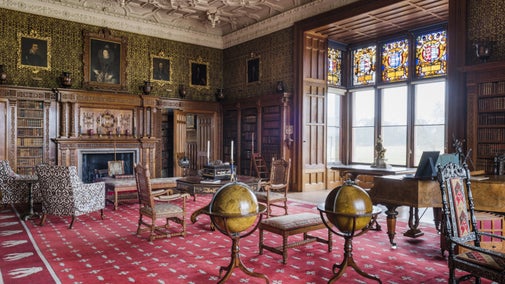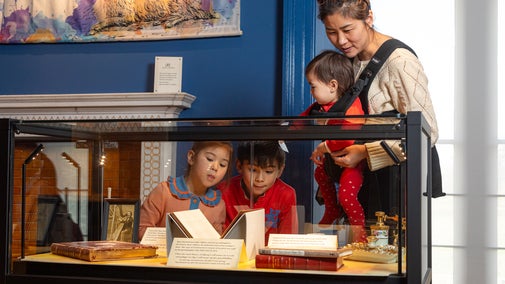
Donate
Everyone needs nature, now more than ever. Donate today and you could help people and nature to thrive at the places we care for.

With its Victorian family home, formal gardens and 180-acre landscaped deer park, Charlecote Park requires lots of conservation work all year round to preserve this special place for generations to come. Learn about some of the projects we’re undertaking indoors and out – from restoring buildings and monitoring collection items, to maintaining healthy habitats for wildlife.
The team work hard to care for house and the collection items across Charlecote every day of the year. With over four floors in the house to cover as well as the Gatehouse and outbuildings in the Service Courtyard, it’s no small task!
Much of our conservation work caring for items in the collection is based on cutting-edge conservation science. Every day we monitor light levels, temperature and humidity indoors, and we regularly survey bugs, pests and mould, which helps to inform our plans for cleaning and caring for the collection.
Working with industry experts throughout the year, the team also use the latest research and reports to plan our conservation work – including things like pest management, how dust falls in a room, and UV light levels.
As well as looking after the house, we also take care of the outbuildings at Charlecote, in order to preserve this historic working area.
We have regular visits from a specialist carriage conservator who comes in to assess the condition of the carriage collection, and to clean each one in turn.
Discover more of our work in the outbuildings on your next visit to Charlecote.

With over 180 acres of parkland in our care, the rangers and a group of volunteers work outdoors all year round to manage the gardens, parkland, and the wildlife at Charlecote Park.
This includes routine maintenance such as repairing footpaths, fences and gates, as well as seasonal work such as haymaking, tree and river management, and caring for the wildflower meadow.
We regularly monitor the condition of our path network and nearby habitats. These can be greatly impacted during the autumn, winter and early spring, when wet conditions create muddy footpaths which can lead to soil compaction and erosion.
To help manage the most vulnerable paths, we often close areas or divert routes to let these spaces rest and recover.
But we still need to carry out conservation work across the rest of the parkland. For this, our team only use vehicles fitted with low pressure tyres, including an All-Terrain Vehicle (ATV) which is designed to be driven in all conditions, whilst limiting impact and erosion of the ground.
Tree inspections are carried out each year to ensure we maintain their long-standing health. We also collect seeds from our eldest trees such as the 300-year-old boundary oak and the mulberry trees, to ensure we can continue their lineage.
Dead wood is dead good! We leave fallen logs or trimmed tree limbs out in the parkland as these create fantastic habitats for bugs, insects, and fungi which go on to supply other ecosystems.
The deer and sheep also help the team with their conservation work. By grazing the land, they help to maintain a varied sward structure of the plants and grasses. This goes on to help create diverse habitats for other insects and wildlife across the parkland.
By maintaining healthy habitats at Charlecote, we can encourage wildlife to thrive here, such as the population of butterflies that make their home in Charlecote’s habitats.
With support from the British Butterfly Trust, we’ve set up three butterfly transects in different areas of the parkland, covering various habitats. The transect involves walking a set route and recording the weather conditions, along with the number and species of butterflies found in a 5-metre-wide corridor along the route.
Thanks to a group of volunteers who help with the transects, we now have three years of detailed butterfly records which will help us identify reliable trends, and ensure we manage the countryside to benefit butterflies and other wildlife.

Elsewhere at Charlecote, we’re working hard to reduce our environmental impact in small but meaningful ways – repairing, re-using and recycling where possible. Here are just some of the ways we’re going green:
With your ongoing support, we're able to continue our vital conservation work. Thank you for helping to protect these special places.

Everyone needs nature, now more than ever. Donate today and you could help people and nature to thrive at the places we care for.
Find out how we’re tackling climate change and improving facilities for Charlecote’s visitors. Discover how these changes may affect your visit, and how your support makes a difference.
From establishing a vibrant wildflower meadow to fixing a temperamental Victorian central heating system, read how your support makes a difference.

Generations of the Lucy family have shaped Charlecote Park over the centuries, read about their triumphs and failures.

Discover a fine example of a Victorian home at Charlecote Park, with its vast collection of treasures and immaculately preserved Victorian kitchen and outbuildings.

There are lots of seasonal highlights to discover in the garden at Charlecote, including a formal riverside parterre, shaded woodland garden and a Victorian summerhouse.

Walk through an estate brimming with wildlife, from fallow deer to spotted Jacob sheep, and find out what else there is to see on a visit to Charlecote Park in Warwickshire.

Read about our strategy, which focuses on restoring nature, ending unequal access and inspiring more people.

We believe that nature, beauty and history are for everyone. That’s why we’re supporting wildlife, protecting historic sites and more. Find out about our work.
